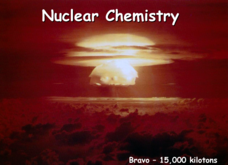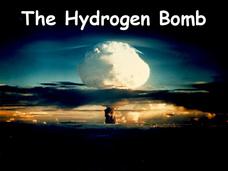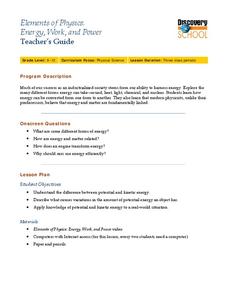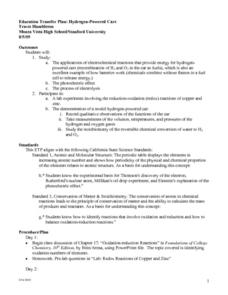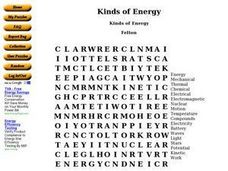It's About Time
Exploring Energy Resource Concepts
Please turn off the lights to conserve energy. Or not, after all energy is always conserved. This first lesson in an eight-part series includes three parts. Part A contains one hands-on activity and two inquiry-based experiments on heat...
Curated OER
Where's the Energy
Students research energy conversions. In this energy lesson, students describe the basic operation of a steam engine. They explain the energy conversions in the steam engine's operation.
Curated OER
Applied Science - Physics Post-Lab
Students investigate energy. In this Physics lesson, students explore different sources of energy: heat, nuclear, and chemical. Students sing an electricity song.
Curated OER
Steamship Portland: Where's the Energy?
Students examine how steamships operate. They describe the necessary energy conversions. They construct a model paddlewheel ship. They use rubber bands as examples of potential and kinetic energy as they unwind and set the models in motion.
Curated OER
Energy Transformations
Students investigate energy and energy transformations. They compare the various forms of energy, create the circuit and sketch the connections. In addition, they label the circuit to identify areas where energy transformation is present.
Science Geek
Nuclear Chemistry
Which bichemicals wash up on shore? Nucleotides! Presentation covers alpha, beta, and gamma radiation. Includes a comparison of fission versus fusion. Presentation is the second in a five-part series.
Science Geek
The Hydrogen Bomb
Recycled Russian nuclear weapons provide 10 percent of the nuclear energy that the United States uses. The short presentation discusses the Teller-Ulam device. It provides a diagram of the parts as well as a description of the four...
Science Matters
Renewable and Nonrenewable Resources
Did you know there are at least 12 different energy sources? Scholars apply their knowledge about the different types of energy as they sort energy sources by renewable and nonrenewable. Then they pick one from each section to...
Curated OER
Atomic Theory
An extremely thorough presentation walks new chemists through the basics of matter. There really isn't a unifying theme, however So many topics are covered: forces, elements, atomic structure, chemical properties, compounds, quarks,...
Curated OER
Conservation of Energy
In this energy learning exercise, students read about the Law of Conservation of Energy and compare the 6 forms of energy. Then students complete 20 matching, 2 short answer, and 6 word problems.
Curated OER
Conservation of Energy
In this energy instructional activity, students review the law of conservation of energy and how energy is transformed from one form to another. Students complete 10 matching, 10 fill in the blank, and 7 problems to solve.
Curated OER
Energy, Work and Power
Students examine the differences between potential and kinetic energy. In this physics lesson students view a video and apply what they learn about energy to apply it to real world situations.
Curated OER
Student Exploration: Energy Conversions
In this earthquake exploration worksheet, students complete 3 prior knowledge questions, then use "Energy Conversions Gizmo" to conduct several activities, completing short answer questions when finished.
Utah Education Network (UEN)
Utah Open Textbook: Chemistry
Technology can help save money and add convenience. The resource offers a free textbook for a complete Chemistry course. The text begins with a review of the scientific method and continues to explain topics such as chemical bonding,...
Clarkson University
Forms, States, and Conversions
Searching for a way to integrate multiple concepts of energy conversion while captivating a middle school audience? This lesson presents topics related to potential and kinetic energy and offers the ability to allow...
Curated OER
Forms of Energy
Fifth graders brainstorm what forms of energy are used in an energy bike listing them on the board with the description placed beside each form for reference. They work in pairs to diagram the energy transformations that occurred while...
Curated OER
Applied Science -Physics (2B) Pre Lab
Second graders look at different types of energy. In this energy lesson plan, 2nd graders define energy and the difference between kinetic and potential energy. They see examples with falling books and a slinky.
Curated OER
Applied Science - Technology (3A) Post Lab
Third graders discuss how energy is created. In this energy instructional activity, 3rd graders look at how a city receives energy and how it is made. They create their own generator using a pin wheel and pipe cleaners.
Curated OER
Magnetic Induction
In this electricity learning exercise, learners learn about magnetic induction plus compare a generator with a motor. Students also review the different kinds of energy and the formulas associated with energy. This learning exercise has...
Curated OER
Hydrogen Powered Cars
Students apply the principles of chemistry to investigate the concept of how a hydrogen powered car works. They study the electrochemical reactions that provide the energy source. Students also record observations in the functioning of a...
Curated OER
Kinds of Energy Word Search
In this energy word search puzzle, middle schoolers identify types of energy and related terms. They identify 18 words from a given list. An answer sheet is provided.
Virginia Department of Education
Predicting Products and Writing Equations
A chemistry lesson presents 14 chemical reactions for scholars to observe, write the equation, and balance the equations. Additionally, it provides ways to extend the activity as it relates to catalysts.
Science Geek
Periodic Trends
If your pupils think Um is the element of confusion, this presentation on period trends can only help. It covers the patterns for atomic radii, ionization energy, and electronegativity across a period and down a group.
Curated OER
Do It Yourself: Energy Transfer Lesson Plan
Fifth graders discuss the different types of energy and experiment with tesla coil to show the three types of energy transfer. They write conclusions in their science journal.







